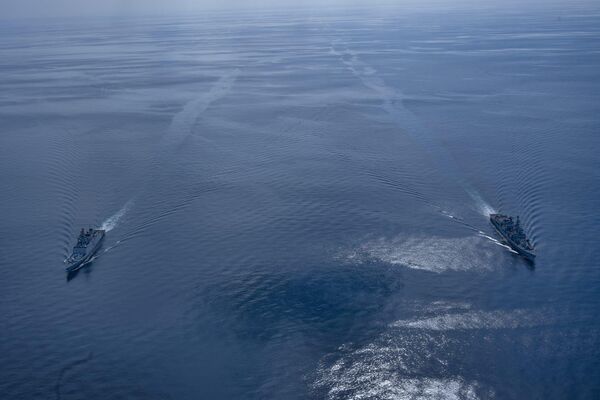
‘Moving Away from US-China Bloc Politics’: What Makes Maiden India-ASEAN Drills Significant?
Singapore and the Indian Navy are co-hosting the maiden ASEAN-India Maritime Exercise (AIME) from May 2 to 8.
The maiden ASEAN-India Maritime Exercise is a “significant reflection” of the deepening and broadening of security relations between India and the 10-member Association for Southeast Asian Nations (ASEAN), a Manila-based geopolitical analyst has told Sputnik.
First-Ever ASEAN-India Maritime Drills
The AIME would involve ships, aircraft and over 1,800 personnel from ASEAN states and India. While the harbour phase is taking place at Changi Naval Base from May 2-4, the sea phase will be held on May 7 and 8 in the South China Sea.
According to Don McLain Gill, the Director for South and Southeast Asia at the Philippine-Middle East Studies Association (PMESA), with these drills, both India and the Southeast Asian want to "move away from the rigid US-China bloc politics” and focus on shared goals and interests.
At the same time, the strategic interests of New Delhi and ASEAN towards the broader Indo-Pacific region are largely convergent as both of them seek to preserve their respective strategic autonomies amid great power rivalry.
“The US has indeed enhanced its military presence in Southeast Asia, which is considered to be the intersection of the traditional sphere of US influence and the emerging locus of Chinese power. Hence, such exercises will provide Southeast Asian countries with more collaborative options to pursue their strategic interests,” Gill remarked.
“Both sides recognise the value of spearheading cooperative approaches to ensure the stability and security of their shared region,” Gill highlighted.
‘Operationalising’ Comprehensive Strategic Partnership
According to Gill, the joint maritime drills were indicative of the fact that the two sides elevated their overall ties to the level of Comprehensive Strategic Partnership at the India-ASEAN Summit in Phnom Penh last November.
As such, New Delhi has said that bolstering of the overall ties with the southeast Asian countries would help both the sides “navigate the sheer uncertain geopolitical landscape”.
India has premised its policy outlook towards Indo-Pacific on ‘ASEAN-centrality’, signifying the geographical centrality of southeast Asia which lies between Indian and Pacific Oceans.
The Backdrop of India-ASEAN Drills
The maiden maritime drills are taking place amid heightened tensions between China and the Philippines in the South China Sea, after the Philippine Coast Guard last week accused Chinese vessels of carrying out "dangerous manoeuvres" and using "aggressive tactics" in Manila’s Exclusive Economic Zone (EEZ).
The incident took place just days after Chinese foreign minister and the Philippine President Ferdinand R. Marcos Jr. agreed to establish “more lines of communication” to resolve contingencies in the South China Sea during their meeting in Manila last month.
Beijing claims sovereignty over the almost the entire South China Sea, putting it at odds with Philippines, Vietnam, Malaysia, Indonesia and Brunei, all of them having conflicting maritime claims. However, China says it is ready to negotiate a ‘Code of Conduct’ with parties involved in the dispute and has firmly opposed the role of external powers like the US.
US President Joe Biden has warned that he would invoke the mutual defense pact under the 1951 treaty in case of an “armed attack” against the Philippines.
Last month, Manila also allowed US access to four additional military bases in the South China Sea amid growing tensions between the world’s biggest economies in the Indo-Pacific.
Go back to the beginningGo back to the main page

